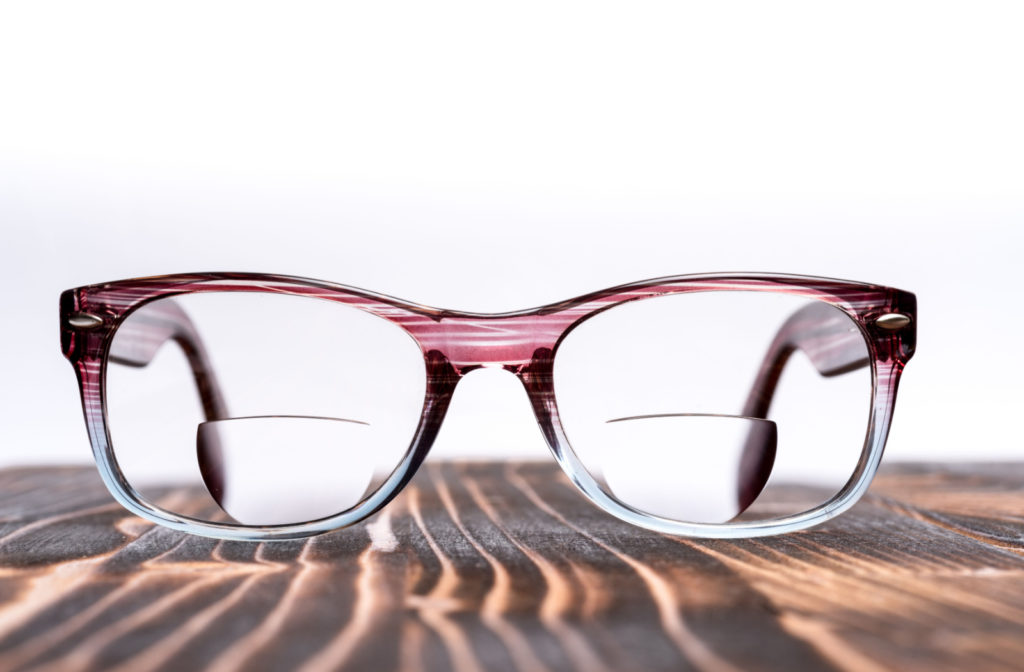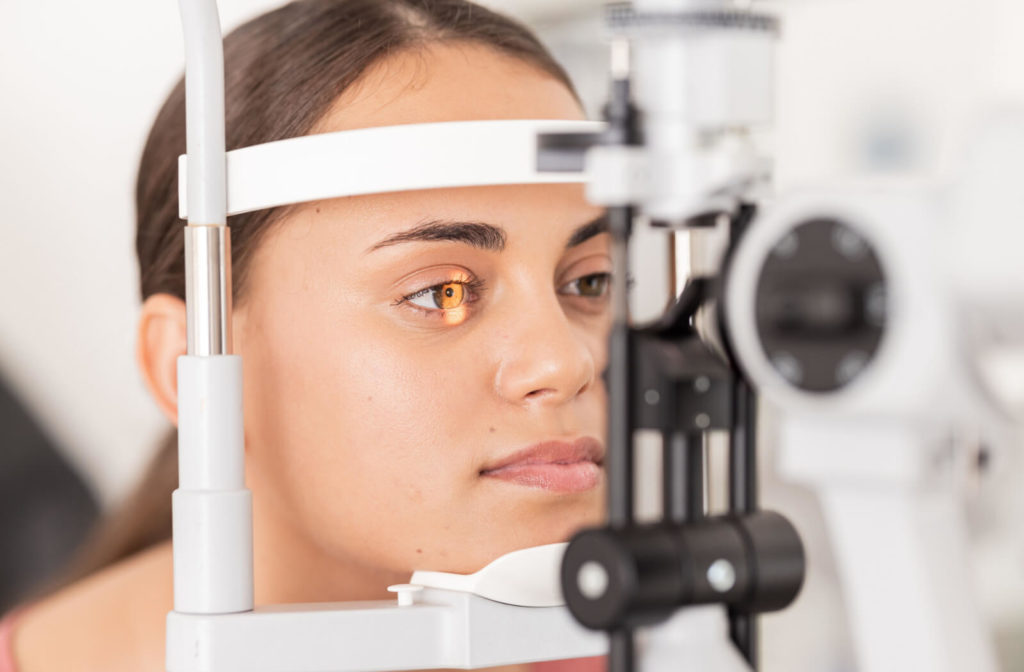Some people over the age of 40 may find themselves needing reading glasses or they may feel like their vision is getting worse. They may be developing presbyopia. This is a common condition that affects many of us as we age. Fortunately, it can be treated with bifocals or progressive lenses. What’s the difference between these 2 types of lenses, though?
Bifocals are eyeglasses with 2 distinct optical powers, with the upper part for distance vision and the lower segmented part for near vision, typically for reading. Whereas Progressive lenses provide a smoother transition between viewing zones, offering clear vision at all distances without the noticeable line dividing the viewing zones found in bifocals.
And, with technology constantly improving, there’s even a specialty type of progressive lens: the Essilor Varilux XR Series.
What Is Presbyopia?
Presbyopia is essentially the loss of your eye’s ability to focus on objects up close. It’s a natural part of aging and usually becomes noticeable in your early to mid-40s.
It’s all about how our eyes’ ability to focus changes over time. In our younger years, the lens inside our eyes is elastic and can change shape easily. That’s how we’re able to adjust from seeing close-up objects to far-away objects clearly. As we get older, this natural elasticity starts to weaken, making it harder for us to focus on things up close.
Some common symptoms of presbyopia include:
- Difficulty reading small print
- Needing to hold reading material at arm’s length
- Straining eyes or headaches after close-up work
- Blurred vision when focusing up close
- Eye fatigue after prolonged screen time
- Squinting to see clearly at a short distance
Presbyopia affects over 7 million Canadians every year, making it an extremely common condition.
How Is Presbyopia Treated?
Since presbyopia is so common, there is good news: most cases can be solved with a quick visit to your optometrist.
Typically, your optometrist will recommend reading glasses, bifocals, or progressive lenses. These are specialty lenses that you can wear as needed, and they’re excellent for helping you achieve clear vision. But what exactly sets them apart from each other?

What Are Bifocals?
Bifocals are eyeglasses with 2 distinct areas of vision correction.
- The lower half of the lens is for reading and other close-up tasks
- The top zone is for viewing things clearly at a distance
Since there are 2 distinct areas of vision, there is often a noticeable line separating the prescriptions in the lens. This can be distracting for some people and may affect their depth perception.
Bifocals are a practical solution for people with presbyopia, but the abrupt change in prescription can take some getting used to.
What Are The Pros of Bifocals?
- Often available at a lower price point than progressive lenses.
- Easy to adapt to for people who’ve worn bifocals before.
What Are The Cons of Bifocals?
- Bifocals have a visible line on the lens, which some may find distracting.
- Limited intermediate vision support.
- The distinct vision zones don’t have gradual transition between them, which can cause a “jump” effect when shifting your focus.
What Are Progressive Lenses?
Progressive lenses are pretty similar to bifocals, but they have a key difference: instead of a clear dividing line separating 2 zones, they blend together smoothly. They provide a range of focus areas in a single lens:
- The top zone is for distant vision
- The center of the lens is for intermediate distance
- The bottom area of the lens is for near vision
And there’s no dividing line between these zones. This makes them more like natural vision than bifocals. These are a popular alternative to bifocals, especially for people who find themselves distracted by the visible dividing line between the vision zones.
Progressive lenses offer a more seamless and gradual change between distances, making them comfortable for many people.
Some first-time users of progressive lenses experience something called the “swim” effect. This feels like temporary dizziness or a loss of balance and is caused by distortion in your peripheral vision. Fortunately, it tends to go away quickly as you get used to these lenses.
What Are The Pros of Progressive Lenses?
- Progressive lenses have no visible transition line, resulting in a smoother transition between distance, intermediate, and near vision.
- Effective for multitasking (for example, switching between driving, computer work, and reading).
What Are The Cons of Progressive Lenses?
- Progressive lenses typically have a more premium price point than bifocals.
- They can sometimes take longer to adjust to, especially if it’s your first time wearing them.
- Your peripheral vision may feel slightly distorted at first while your brain adjusts.

The Essilor Varilux XR
One of the most popular progressive lenses available today is the Essilor Varilux XR. These lenses are designed to provide sharp vision and smooth transitions at any distance—without side effects like the “swim” effect. These specialty lenses use advanced technology to provide all the benefits of progressive lenses.
Each lens has multiple viewing zones:
- The top zone ensures clear distant vision. This is useful for when you’re outside and need to see things far away, or for activities like going to the movies.
- The middle zone assists with intermediate vision. This is ideal for activities like using a computer screen or watching TV at home.
- The bottom zone is specifically designed for near vision, making it easier to read a book or examine small objects with clarity. This area is extremely useful for tasks that need specific, intense focus.
What makes these lenses incredible is the smooth transition between these zones. These lenses use cutting-edge technology when they’re designed, and they blend these different zones together in an almost unnoticeable way.
Unlike the sudden jump in clarity between the 2 halves of a bifocal lens, the Varilux XR creates a gradual shift from 1 focus area to the next. This provides a natural visual experience, mimicking how our eyes naturally view different distances.
So, whether you are concentrating on a close-up task or appreciating a distant view, these lenses adjust seamlessly, allowing you clear and comfortable vision at all times.
To get this result, there are three different types of exclusive tech at play:
- The XR Motion™, which optimizes both lenses using AI-predicted technology. This matches your prescription and aims to predict your visual behavior to give you clear, sharp vision.
- Nanoptix®, which targets the periphery of the lenses. This minimizes distortion while widening your field of vision. Instead of the lens being a single curve, it’s made up of tiny curves to better control how light enters the eye.
- Xtend®, which lets you see clearly at arm’s length. This tech provides clear vision by blending nearby and intermediate distances seamlessly, which can be extremely helpful when performing tasks like reading on a tablet or using a smartphone.
Together, these three technologies provide incredible sharp vision at all distances, helping correct presbyopia to minimize its effect on your life.
Benefits of the Essilor Varilux XR Lenses
Essilor Varilux XR lenses have become popular because they provide:
- Clear vision at any distance
- Smooth transitions between different focal points
- Reduced strain for close-up work
- Greater comfort for daily wear
- Enhanced peripheral vision
- UV protection for eye health

Where to Get Help for Your Vision
Presbyopia can cause blurry vision as we age, but with the help of progressive lenses and bifocals, it’s easy to help you achieve clear vision.
At West Coast Optical, we’re committed to helping you see clearly and comfortably. Our team of experienced optometrists can guide you through your options and find the perfect solution for your eyes. To speak with one of our opticians about the different options—like the Essilor Varilux XR series—book your appointment today.



